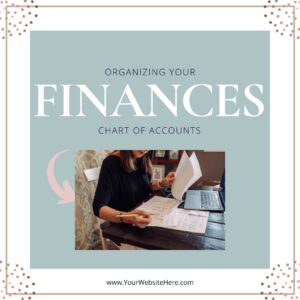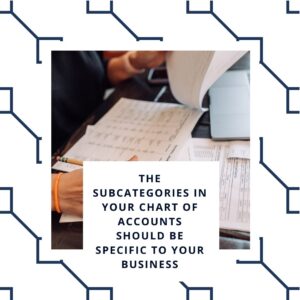
You’ve done it. You’ve decided to start a small business, call it consulting, your passion, a side gig, you are ready. You bought a laptop, purchased a business license, did a little marketing, now what? Where do you put these expenses? Are they all charged to the same operating line? Or, maybe you’re opened and booking business, but accounting isn’t your dig. The dull thought of eyeing numbers and trying to digest what’s financially happening makes you nauseous. But you know that organizing your finances is a must.
Where do you start? Even better, why start?! You’re confident you’re making money, right?
To understand if your hard work is paying off, organizing your finances is the most crucial step. Whether you use Excel or some other bookkeeping software, a business of any size needs to balance and categorize every debit and credit that hits your bank account (cash-based accounting) and maybe even every business transaction that occurs (accrual-based accounting).

Being the savvy entrepreneur that you are, you know to compare revenue against expenses to see if you’re profitable. Easy enough, right? But how do you maximize your profits in the months to come? Are you confident you’re filing your taxes correctly? What products and services are at the forefront of your business? Is your Cost of Goods Sold (COGS) markup sustainable? How much are you spending on payroll, operating supplies, and annual dues?
Finally, the million-dollar question: are these expenses in line with your income? You’ll be able to answer everything if you’re organizing your finances.
If you’ve made it this far and you’re confident in how your finances are organized and represented on the Profit and Loss statement (P&L), check out our Reading your P&L series for insight on how to identify concerns about your business using your financial reports. But, if you’re like many small business owners, you’ve likely glazed over.
<sigh>
Take a deep breath, refresh your coffee, and let’s talk through this; it’s not as daunting or as dull as it sounds. This article will explain what the chart of accounts is and why it has to be detailed to navigate your business. Let’s begin.
What is the chart of accounts when organizing your finances?
There are five categories in the Chart of Accounts: Assets, Liabilities, Owner’s Equity, Revenue, and Expenses. The first three categories appear on your balance sheet, the latter two on your income statement or P&L. Investopedia describes the chart of accounts as, “…a financial organizational tool that provides a complete listing of every account… broken down into subcategories.” The key to the chart of accounts is the subcategories.
Far too often, small business owners don’t use subcategories for revenue and expenses. When there is a lack of detail in these categories, you will not have the information needed to optimize your business.
To help you understand this concept, I’m going to apply the “financial organizational tool” to your everyday life using your clothing dresser. Your dresser in this analogy is your income statement.
Imagine it’s Friday and you get home late from work. You need to change your clothes and head to dinner with friends. In a hurry, you open the first drawer because this is where you keep ALL your t-shirts: shirts you sleep in, workout in, and shirts you wear when you go out to dinner. Unfortunately, you don’t keep your drawer organized. You begin to dig through your top drawer looking for a new t-shirt you’re excited to wear but can’t find it.
At this point, you’ve wasted so much time you’ll definitely miss out on appetizers. Finally, with a knee jerk reaction, you reach in, pull out what you can find, and go with it. You pick out a shirt that will work, not a terrible shirt, but not your best showing.
To avoid this in the future, you decide to organize your t-shirt drawer by adding partitions to separate your t-shirts into three distinct piles: sleep, workout, socializing. In doing so, you now know exactly where to look for the shirt you need based on the occasion. You’ll also have visibility on how many shirts there are in each category and if you need more.

Now that you organized your t-shirt drawer, when you open it, you can make informed decisions. As a business owner, your goal is to have the same level of visibility on your financial statements. Next, apply the organization of the t-shirt drawer to revenue. Each t-shirt partition is a revenue subcategory.
Now you can see the dollar amount each revenue type is contributing to your total income and what changes need to be made based on performance. Once you start organizing your finances, decisions are much easier to make. Below you can see the t-shirt drawer next to an example of a revenue chart of accounts with subcategories. Your revenue subcategories will likely be different than the examples provided above. That’s the fun part of creating your chart of accounts. Outside of following the Generally Acceptable Accounting Principles (GAAP), the subcategories in your Chart of Accounts should be specific to your business. Some examples of revenue subcategories are IT Consulting, Yoga Classes, transmission replacement, or rental revenue.
Why is this important?
You’re busy. By adding subcategories to your chart of accounts, you can see in detail what is impacting your business and how. In addition to seeing your revenue by type, once you create subcategories for your expenses, you will see what you spent on payroll, your COGS ratio, and any level of expense detail that is valuable to your company. Some examples of operating expense subcategories are Travel & Entertainment, Office Supplies, Legal Fees, Contract Services, you name it.
More importantly, you can financially optimize your business. 50% of small businesses fail within the first five years, and according to Shopkeep.com, the failure rate is due to the lack of real-time data on business performance.
Detailing your chart of accounts will give you visibility on what products and services are driving your income and help you make decisions that will impact the bottom line and help you navigate dynamic markets. Simply put, to understand the financial fitness of your business, you need to create subcategories in your chart of accounts.
Finally, your taxes. The Expert Panel, Forbes Finance Council, recommends that you review your chart of accounts well before tax season. The February 2020 article outlines 13 action items all businesses, big and small, should do before filing their taxes. Number two on their list, review your chart of accounts.
HELP! I’m already operating and don’t have subcategories set up
Let me assure you, you’re not alone if you haven’t already begun organizing your finances, but you do have some work to do. You need to create subcategories and organize any forward-looking financials. You will likely need to update prior months and years, depending on your situation. This is especially important for tax reporting and any year over year analysis. If the thought of doing this exercise is nauseating, call us, it’s what we do.
Time to organize your drawer
Ensuring your chart of accounts has enough detail is essential to your success. Your financial statements tell the story of your business in a unique and powerful way. One of the biggest mistakes a small business owner can make is assuming that your accountant or your bookkeeping software will add the needed details that are specific to your business and how you operate.
As the owner, you should be able to pick up your Income Statement, look at it, and understand how and why you had the profit or loss that you did. If you’re not at this point, it’s time to organize your drawer.







